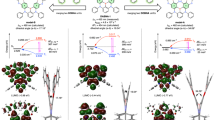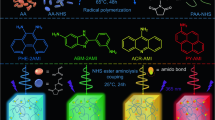Abstract
Commercial carbazole has been widely used to synthesize organic functional materials that have led to recent breakthroughs in ultralong organic phosphorescence1, thermally activated delayed fluorescence2,3, organic luminescent radicals4 and organic semiconductor lasers5. However, the impact of low-concentration isomeric impurities present within commercial batches on the properties of the synthesized molecules requires further analysis. Here, we have synthesized highly pure carbazole and observed that its fluorescence is blueshifted by 54 nm with respect to commercial samples and its room-temperature ultralong phosphorescence almost disappears6. We discover that such differences are due to the presence of a carbazole isomeric impurity in commercial carbazole sources, with concentrations <0.5 mol%. Ten representative carbazole derivatives synthesized from the highly pure carbazole failed to show the ultralong phosphorescence reported in the literature1,7,8,9,10,11,12,13,14,15. However, the phosphorescence was recovered by adding 0.1 mol% isomers, which act as charge traps. Investigating the role of the isomers may therefore provide alternative insights into the mechanisms behind ultralong organic phosphorescence1,6,7,8,9,10,11,12,13,14,15,16,17,18.
This is a preview of subscription content, access via your institution
Access options
Access Nature and 54 other Nature Portfolio journals
Get Nature+, our best-value online-access subscription
$29.99 / 30 days
cancel any time
Subscribe to this journal
Receive 12 print issues and online access
$259.00 per year
only $21.58 per issue
Buy this article
- Purchase on Springer Link
- Instant access to full article PDF
Prices may be subject to local taxes which are calculated during checkout




Similar content being viewed by others
Data availability
The data that support the findings of this study are available from C.C. and L.B. upon reasonable request. The X-ray crystallographic data for the structures reported here have been deposited at the Cambridge Crystallographic Data Centre (CCDC) under deposition numbers CCDC 1953802–1953811 and 2019581–2019589. These data can be obtained free of charge from the Cambridge Crystallographic Data Centre at www.ccdc.cam.ac.uk/data_request/cif. Source data are provided with this paper.
References
An, Z. et al. Stabilizing triplet excited states for ultralong organic phosphorescence. Nat. Mater. 14, 685–690 (2015).
Uoyama, H., Goushi, K., Shizu, K., Nomura, H. & Adachi, C. Highly efficient organic light-emitting diodes from delayed fluorescence. Nature 492, 234–238 (2012).
Hamze, R. et al. Eliminating nonradiative decay in Cu(I) emitters: >99% quantum efficiency and microsecond lifetime. Science 363, 601–606 (2019).
Ai, X. et al. Efficient radical-based light-emitting diodes with doublet emission. Nature 563, 536–540 (2018).
Sandanayaka, A. S. D. et al. Indication of current-injection lasing from an organic semiconductor. Appl. Phys. Express 12, 061010 (2019).
Bilen, C. S., Harrison, N. & Morantz, D. J. Unusual room temperature afterglow in some crystalline organic compounds. Nature 271, 235–237 (1978).
Cai, S. et al. Visible-light-excited ultralong organic phosphorescence by manipulating intermolecular interactions. Adv. Mater. 29, 1701244 (2017).
Xie, Y. et al. How the molecular packing affects the room temperature phosphorescence in pure organic compounds: ingenious molecular design, detailed crystal analysis, and rational theoretical calculations. Adv. Mater. 29, 1606829 (2017).
Xiong, Y. et al. Designing efficient and ultralong pure organic room-temperature phosphorescent materials by structural isomerism. Angew. Chem. Int. Ed. 57, 7997–8001 (2018).
Zhang, T. et al. Pure organic persistent room-temperature phosphorescence at both crystalline and amorphous states. ChemPhysChem 19, 2389–2396 (2018).
Gong, Y. et al. Achieving persistent room temperature phosphorescence and remarkable mechanochromism from pure organic luminogens. Adv. Mater. 27, 6195–6201 (2015).
Yang, Z. et al. Intermolecular electronic coupling of organic units for efficient persistent room-temperature phosphorescence. Angew. Chem. Int. Ed. 55, 2181–2185 (2016).
Fateminia, S. M. A. et al. Organic nanocrystals with bright red persistent room-temperature phosphorescence for biological applications. Angew. Chem. Int. Ed. 56, 12160–12164 (2017).
Kenry, Chen,C. & Liu, B. Enhancing the performance of pure organic room-temperature phosphorescent luminophores. Nat. Commun. 10, 2111 (2019).
Xue, P. et al. Correction: Bright persistent luminescence from pure organic molecules through a moderate intermolecular heavy atom effect. Chem. Sci. 8, 6691–6691 (2017).
Gu, L. et al. Dynamic ultralong organic phosphorescence by photoactivation. Angew. Chem. Int. Ed. 57, 8425–8431 (2018).
Zhao, W. et al. Boosting the efficiency of organic persistent room-temperature phosphorescence by intramolecular triplet-triplet energy transfer. Nat. Commun. 10, 1595 (2019).
Mao, Z. et al. Two-photon-excited ultralong organic room temperature phosphorescence by dual-channel triplet harvesting. Chem. Sci. 10, 7352–7357 (2019).
Li, Y., Gecevicius, M. & Qiu, J. Long persistent phosphors—from fundamentals to applications. Chem. Soc. Rev. 45, 2090–2136 (2016).
Kabe, R. & Adachi, C. Organic long persistent luminescence. Nature 550, 384–387 (2017).
Lastusaari, M. et al. The Bologna Stone: history’s first persistent luminescent material. Eur. J. Miner. 24, 885–890 (2012).
Matsuzawa, T., Aoki, Y., Takeuchi, N. & Murayama, Y. A new long phosphorescent phosphor with high brightness, SrAl2O4:Eu2+,Dy3+. J. Electrochem. Soc. 143, 2670–2673 (1996).
Clapp, D. B. The phosphorescence of tetraphenylmethane and certain related substances. J. Am. Chem. Soc. 61, 523–524 (1939).
Graebe, C. & Glaser, C. Ber. Dtsch. Chem. Ges. 5, 12 (1872).
Feng, H. et al. Tuning molecular emission of organic emitters from fluorescence to phosphorescence through push-pull electronic effects. Nat. Commun. 11, 2617 (2020).
Chen, C. et al. Intramolecular charge transfer controls switching between room temperature phosphorescence and thermally activated delayed fluorescence. Angew. Chem. Int. Ed. 57, 16407–16411 (2018).
Noda, H. et al. Critical role of intermediate electronic states for spin-flip processes in charge-transfer-type organic molecules with multiple donors and acceptors. Nat. Mater. 18, 1084–1090 (2019).
Bolton, O., Lee, K., Kim, H.-J., Lin, K. Y. & Kim, J. Activating efficient phosphorescence from purely organic materials by crystal design. Nat. Chem. 3, 205–210 (2011).
Ullah, E., McNulty, J. & Robertson, A. Highly chemoselective mono-Suzuki arylation reactions on all three dichlorobenzene isomers and applications development. Eur. J. Org. Chem. 2012, 2127–2131 (2012).
Yang, L., Zhang, Y., Zou, X., Lu, H. & Li, G. Visible-light-promoted intramolecular C–H amination in aqueous solution: synthesis of carbazole. Green. Chem. 20, 1362–1366 (2018).
Acknowledgements
This study was supported by the Singapore National Research Foundation (NRF) Competitive Research Program (R279-000-483-281), the NRF Investigatorship (R279-000-444-281) and the National University of Singapore (R279-000-482-133).
Author information
Authors and Affiliations
Contributions
C.C. and B.L. designed the experiments. C.C. optimized the HPLC and grew crystals. C.C., Z.C., Z.Y., Z.M. and Z.Y. contributed to the optical characterizations. C.C. and K.C.C. synthesized all compounds. A.S.B. and C.C. solved the crystal structures. C.C. and B.L. discussed the results and drafted the manuscript. B.L. supervised the project. All authors contributed to the proofreading of the manuscript.
Corresponding author
Ethics declarations
Competing interests
The authors declare no competing interests.
Additional information
Publisher’s note Springer Nature remains neutral with regard to jurisdictional claims in published maps and institutional affiliations.
Supplementary information
Supplementary Information
Supplementary methods, Scheme 1, Figs. 1–37 and Tables 1–11.
Source data
Source Data Fig. 1
HPLC spectra of TCI-Cz.
Source Data Fig. 2
HPLC spectra monitored at the onset absorption of 346 nm for Cz and 354 nm for CPhCz.
Source Data Fig. 3
Emission characteristics with different isomer doping concentrations.
Source Data Fig. 4
Transient absorption and photoluminescence.
Rights and permissions
About this article
Cite this article
Chen, C., Chi, Z., Chong, K.C. et al. Carbazole isomers induce ultralong organic phosphorescence. Nat. Mater. 20, 175–180 (2021). https://doi.org/10.1038/s41563-020-0797-2
Received:
Accepted:
Published:
Issue Date:
DOI: https://doi.org/10.1038/s41563-020-0797-2
This article is cited by
-
Understanding the AIE phenomenon of nonconjugated rhodamine derivatives via aggregation-induced molecular conformation change
Nature Communications (2024)
-
Unraveling the crucial role of trace oxygen in organic semiconductors
Nature Communications (2024)
-
A direct observation of up-converted room-temperature phosphorescence in an anti-Kasha dopant-matrix system
Nature Communications (2023)
-
Efficient room-temperature phosphorescence of covalent organic frameworks through covalent halogen doping
Nature Chemistry (2023)
-
Room temperature phosphorescence from natural wood activated by external chloride anion treatment
Nature Communications (2023)



